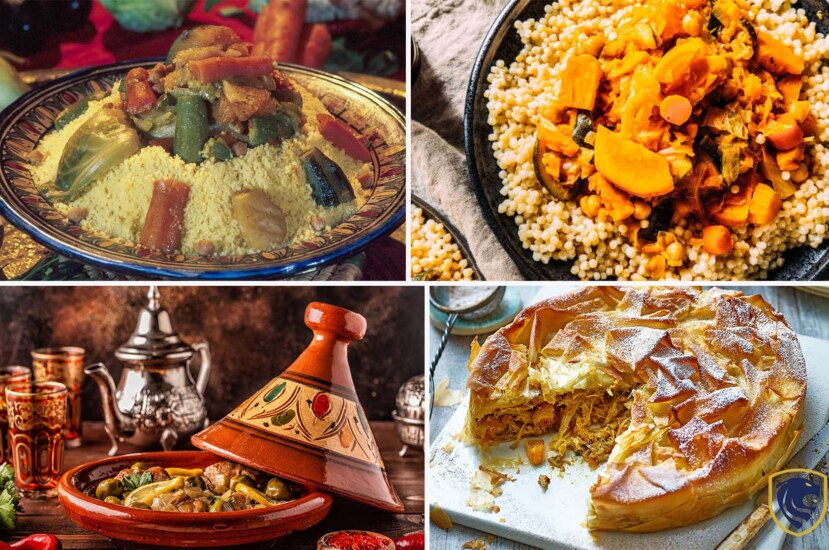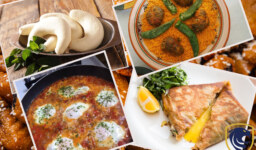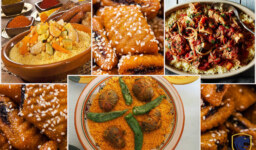Welcome to a delectable trip through the vivid and enthralling world of Moroccan food. In this post, we’ll go on a gastronomic excursion, savoring the flavors of Morocco. Also, we are discovering the enticing joys of its traditional food. Morocco’s rich culinary tradition reflects its unique history and cultural influences, nestled between the Mediterranean Sea and the Sahara Desert. Every meal offers a narrative of history, family, and community, from the busy souks packed with aromatic spices to the warm welcome of Moroccan homes. So, We’ll discover the secrets of renowned Moroccan dishes like tagine, couscous, pastilla, harira, and mechoui. Each mouthful transmits the essence of Morocco’s historical history and exhibits the creativity of the Moroccans.
Tagine
Tagine, called after the clay pot in which it is prepared, is one of the most famous dishes in Moroccan cuisine. This classic meal has a wonderful combination of flavors and comes in a variety of varieties, including lamb, chicken, and veggie. The distinctive cone-shaped lid of the tagine allows steam to flow. That results in soft and succulent meat or veggies.
The rich combination of spices such as cumin, coriander, cinnamon, and saffron is the secret to a delectable tagine. Moreover, the aromatic spice blend fills the meal with a tantalizing scent. Moroccan tagines are frequently made with a delectable combination of ingredients. The list includes dried fruits like apricots and prunes, which provide a delicious sweetness. Also, these components are blended with savory elements like olives and preserved lemons to produce a flavorful balance. Tagine is typically served with couscous, another popular Moroccan side dish. So, the fluffy couscous compliments the soft tagine, resulting in a beautiful texture marriage.

Tagine; Savoring the Flavors of Morocco
A tagine in Morocco is an experience that tantalizes both the taste and the spirit, as it symbolizes the country’s rich history and cultural heritage. Tagine, with its tempting combination of spices and exquisite flavors, is a beloved icon of traditional Moroccan cuisine. Moreover, it allows travelers to go on a fascinating gastronomic trip through Moroccan flavors.
Couscous
Couscous, recognized for its fluffy and airy texture, is a cherished and traditional dish in Moroccan cuisine. It is usually cooked and served with numerous accompaniments made from semolina wheat. The preparation of couscous entails the expert hand-rolling of semolina grains into little pellets. It is a method passed down through generations. Couscous is a versatile palette for a variety of flavors. Also, it is frequently combined with juicy meats like lamb or chicken. In addition, it can be combined with vegetables like carrots, zucchini, and onions. The couscous meal is boosted with fragrant spices like turmeric, cumin, and paprika, resulting in a symphony of flavors that delight the taste receptors.

Couscous; Savoring the Flavors of Morocco
Couscous is frequently served with a rich and fragrant broth, allowing the grains to absorb the savory liquid and enhance its flavor and texture. Moreover, Moroccans share couscous at significant occasions and gatherings to symbolize kindness, hospitality, and unity. Savoring a plate of couscous in Morocco is an important gastronomic experience for both locals and visitors, providing a delicious interaction with the heart and spirit of traditional Moroccan cuisine.
Pastilla
Pastilla is a Moroccan delicacy that exhibits the technique of combining sweet and savory flavors. Traditionally stuffed with pigeon or chicken, the meal also contains almonds, eggs, and aromatic spices like cinnamon and saffron. Pastilla is made with elaborate layers of tiny pastry sheets, each coated with melted butter to create a delicate and flaky texture. In addition, the pastilla is coated with powdered sugar and ground cinnamon after it has been cooked to golden perfection. This brings a wonderful sweetness to offset the savory contents. Pastilla’s contrasting flavors and textures are a sensory delight, with delicate beef and nutty almonds creating a delightful symphony.

Pastilla; Savoring the Flavors of Morocco
Pastilla is frequently offered as a special meal at festive events and festivals, representing hospitality and generosity. Sharing pastilla is a manner of expressing love and thanks to guests in Moroccan culture. That makes it a treasured and appreciated delicacy. Pastilla is a real symbol of Moroccan culinary expertise. Furthermore, it is a must-try for every traveler looking to experience the authentic and enticing joys of traditional Moroccan food. Indulging in a slice of pastilla is an invitation to discover Morocco’s distinct and tantalizing flavors, creating a lasting impression of the country’s rich culinary heritage.
Harira
Harira is a classic Moroccan soup. It is a popular and filling dish that is frequently connected with Ramadan, the holy month of fasting. This savory and healthy soup is created with a hearty combination of tomatoes, lentils, chickpeas, and fragrant herbs such as coriander and parsley. Harira’s nutritional benefits and soothing taste make it a key element of the Iftar meal, the evening meal to break the fast during Ramadan. Slow-cooking the soup’s components allows the flavors to merge and creates a pleasant combination of spices. Moreover, Harira is a sign of connection and community, since it is commonly shared with family and friends during Ramadan events.

Harira; Savoring the Flavors of Morocco
Moroccans believe that Harira replenishes nutrients and restores vigor after a day of fasting, making it an important part of the Ramadan celebration. Beyond Ramadan, Harira is enjoyed all year, providing comfort and warmth throughout the colder months. Furthermore, its healthful and tasty ingredient mix reflects Morocco’s unique culinary tradition. Harira is frequently served with dates, figs, and traditional desserts, which add to the meal’s richness. Savoring a bowl of Harira is an invitation to enjoy the spirit of Moroccan hospitality and the enticing joys of traditional Moroccan cuisine for both residents and visitors.
Mechoui
Moroccan culinary pleasure mechoui is a luscious and soft roasted lamb that maintains a particular position in Moroccan cuisine. This tasty meal is typically served at festive events and festivals. Mechoui is made by marinating lamb in a mixture of fragrant spices. The list of spices includes cumin, paprika, coriander, and garlic, infusing it with a tantalizing scent. The lamb is slow-roasted over open flames or in an underground pit after being marinated, enabling the flesh to become soft and succulent while the skin crisps and golden. The precision of roasting Mechoui is typically passed down through generations, highlighting Moroccan families’ ancestry and culinary ability.

Mechoui; Savoring the Flavors of Morocco
Sharing Mechoui is a symbol of unity and hospitality in Moroccan culture since it brings families and communities together during joyful events. Mechoui’s soft and tasty meat, mixed with delightful spices, produces an appealing sensory feast. So, visitors to Morocco may sample the original flavors of Mechoui at traditional festivities. Because there it is frequently served as a centerpiece dish. Indulging in Mechoui is an invitation to experience Moroccan hospitality at its heart and soul, creating a lasting impression of the country’s rich culinary traditions.




